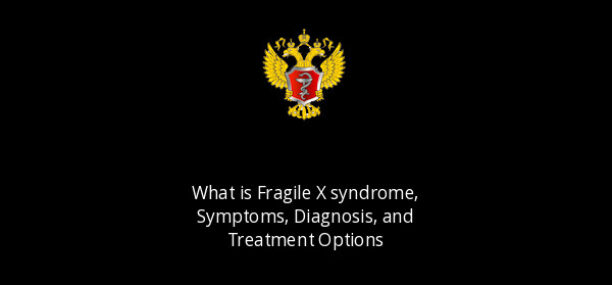Fragile X syndrome (FXS) is a genetic disorder that causes a range of developmental and behavioral problems, including learning disabilities, cognitive impairment, and social and emotional difficulties. FXS is caused by mutations in the FMR1 (Fragile X Mental Retardation 1) gene, located on the X chromosome. Here’s an overview of FXS:
Underlying Conditions:
- Fragile X syndrome is the most common inherited cause of intellectual disability and autism spectrum disorder.
- FXS is characterized by a triplet repeat expansion (CGG repeats) in the FMR1 gene, leading to methylation and silencing of the gene, resulting in reduced production of the fragile X mental retardation protein (FMRP).
Predisposing Factors:
- The expansion of CGG repeats in the FMR1 gene is the underlying genetic cause of Fragile X syndrome.
- Individuals with a premutation (55-200 CGG repeats) in the FMR1 gene are carriers and may be at risk of developing Fragile X-associated disorders, including Fragile X-associated primary ovarian insufficiency (FXPOI) and Fragile X-associated tremor/ataxia syndrome (FXTAS).
Prevalence and Distribution:
- Fragile X syndrome occurs in all racial and ethnic groups but may be underdiagnosed in certain populations.
- The prevalence of FXS is estimated to be approximately 1 in 4,000 to 1 in 7,000 males and 1 in 8,000 to 1 in 11,000 females.
Most Affected Categories:
- Fragile X syndrome affects both males and females, but males are typically more severely affected due to X-linked inheritance.
- Females with FXS may have milder symptoms due to the presence of a second X chromosome, which may compensate for the mutation.
Inheritance:
- Fragile X syndrome is typically inherited in an X-linked dominant pattern, with the premutation and full mutation alleles passed from carrier mothers to their offspring.
- In some cases, FXS may occur sporadically due to de novo mutations or expansions in the FMR1 gene.
Specific Symptoms:
- Intellectual disability and developmental delays
- Social and communication difficulties
- Anxiety and mood disorders
- Attention deficits and hyperactivity
- Sensory processing difficulties
- Physical features such as long face, large ears, and macroorchidism (enlarged testicles in males)
When to Suspect Fragile X Syndrome:
- Fragile X syndrome should be considered in individuals with unexplained developmental delays, intellectual disability, autism spectrum disorder, or a family history of Fragile X-associated disorders.
- Suspect FXS in females with premature ovarian insufficiency or early menopause.
Diagnosis:
- Diagnosis of Fragile X syndrome is confirmed through genetic testing to detect CGG repeat expansions in the FMR1 gene.
- Testing may include polymerase chain reaction (PCR) analysis and Southern blot analysis to assess the size and methylation status of CGG repeats.
Therapeutic Options:
- Management of Fragile X syndrome involves a multidisciplinary approach, including early intervention, behavioral therapy, educational support, and medication management for associated symptoms.
- Therapeutic options may include behavioral interventions, speech therapy, occupational therapy, and pharmacological treatment for anxiety, attention deficits, and other behavioral issues.
- Genetic counseling is recommended for individuals and families affected by Fragile X syndrome to discuss inheritance patterns, reproductive options, and available support resources.
Currently, there is no specific gene therapy approved for Fragile X syndrome. However, researchers are actively investigating various approaches to gene therapy and targeted treatments for Fragile X syndrome, including:
- Gene Editing: Techniques such as CRISPR-Cas9 are being explored for their potential to correct the underlying genetic mutation in Fragile X syndrome. CRISPR-Cas9 allows for precise modification of the FMR1 gene to restore normal function and protein production.
- RNA-Based Therapies: RNA-based therapies, including antisense oligonucleotides (ASOs) and small interfering RNAs (siRNAs), are being investigated to target the abnormal RNA molecules produced by the mutated FMR1 gene. These therapies aim to reduce the levels of abnormal RNA and restore normal protein expression.
- Pharmacological Approaches: Several pharmaceutical companies are developing drugs that target specific pathways affected by Fragile X syndrome, such as metabotropic glutamate receptor (mGluR) signaling. These drugs aim to modulate neuronal activity and improve cognitive and behavioral symptoms associated with Fragile X syndrome.
While gene therapy holds promise for the future treatment of Fragile X syndrome, it is still in the experimental stages, and further research is needed to evaluate safety and efficacy in human clinical trials.
As for prevention, Fragile X syndrome is a genetic condition caused by mutations in the FMR1 gene. It is inherited in an X-linked dominant pattern, meaning that individuals with the mutated gene are at risk of passing it on to their offspring. However, not all carriers of the FMR1 mutation will develop Fragile X syndrome, and the severity of symptoms can vary widely among affected individuals.
Currently, there are no known methods to prevent Fragile X syndrome before conception. However, couples who are carriers of the FMR1 mutation or have a family history of Fragile X syndrome may consider genetic counseling and testing before planning a pregnancy. Genetic counseling can help individuals understand their risk of having a child with Fragile X syndrome and explore options such as preimplantation genetic diagnosis (PGD) or prenatal testing to identify affected pregnancies
Additionally, researchers are investigating potential strategies for preventing or mitigating the effects of Fragile X syndrome through early intervention and targeted treatments. These efforts focus on improving early diagnosis, providing supportive therapies and interventions, and developing novel treatments to address the underlying biological mechanisms of the condition.
Verified by: Dr.Diab (March 29, 2024)
Citation: Dr.Diab. (March 29, 2024). What is Fragile X syndrome, Symptoms, Diagnosis, and Treatment Options. Medcoi Journal of Medicine, 4(2). urn:medcoi:article32639.












There are no comments yet
Or use one of these social networks